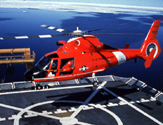
A Coast Guard Dauphin helicopter lifts off from
the USCGC Healy's flight deck on its way to scout
for suitable areas for the ship's ice testing mission.
These helicopters still serve their search and
rescue mission aboard the Healy,
but are also very useful in conducting scientific research.
(Schauer)
|
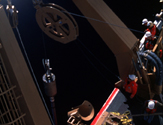
A smaller A-frame and winch assembly than the one found
on the Healy's stern is used to lift the coring
assembly rom the cradle and then gradually lower
it over the starboard side.
(Schauer)
|

An empty housing, which would typically contain sensors,
is added to th cable of the legnthening mooring.
Housings such as this one may contain sensors for oceanographic data
such as temperature, light, density and conductivity.
The data can be gathered over long periods of time
while the mooring is left at sea and then collected when the
morring is later recovered.
(Schauer)
|

Science technicians and Coast Guard crew
assemble the pieces of the mooring as it is
lowered over the stern of the ship.
Moorings may be as long as 4000m
and are assembled piece by piece as they
are lowered into the water.
(Schauer)
|
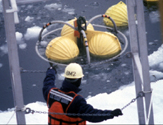
A thirty foot long piston core is assembled on the
starboard side of USCGC Healy. The corer will be
used to sample sediment layers at the ocean bottom.
(Schauer)
|

Yellow balls, which are plastic housings that enclose
large glass balls, dot the deck of USCGC Healy
as the test mooring is assembled. The glass balls
provide flotation for the morring keeping all the
equipment from sinking to the sea floor and will
later bring the equipment to the surface
when the morring is released from its sea floor anchor.
(Schauer)
|
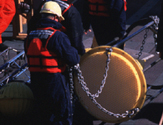
A sediment trap, which is used to collect material settling
through the water column, is another piece of equiptment
that may make up a portion of a mooring.
Sediment traps give scientists and idea of what
is present in the ocean waters at different times of year
and the rate at which the material is changing places
throughout the ocean.
(Schauer)
|
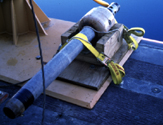
A small version of the piston core is lowered ahead
of the main assembly and is used as a trigger to release
the main assembly at a designated distance above the ocean bottom.
The core of sediments collected by this much shorter section of pipe
can be used to see if the main core actually collected an undistrubed surface layer.
This is accomplished by comparing the trigger core's top layer
with the main core's top layer. If the main core went in too deep,
its top layer will not match the one from the bigger.
(Schauer)
|
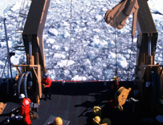
The A-frame on the stern of the USCGC is used to lower a
variety of equipment into the water behind the ship.
In this case, the equipment is a test mooring 400m long.
(Schauer)
|


